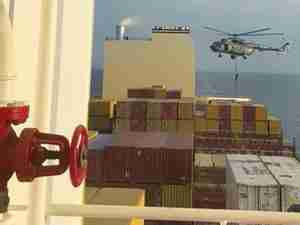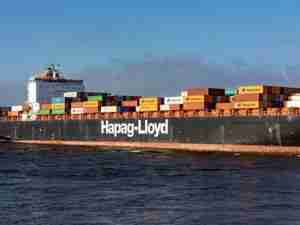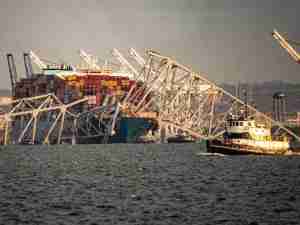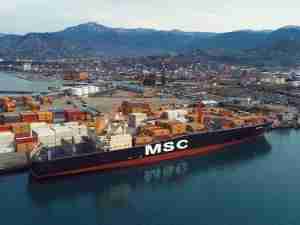Hamburg Süd 2014: Setting the course for the future
posted by AJOT | Apr 23 2015 at 03:07 PM | Liner Shipping
While global economic growth in 2014 remained at previous year’s level with 3.4 per cent, container shipments increased at a considerably higher rate of 5.4 per cent compared with the previous year (3.6 per cent). However, available global slot capacity on board container ships also increased in the past year, outpacing container transport volume. Consequently, it was not possible to reduce the existing overcapacity and freight rates in most trades declined further. A positive effect came from fuel prices, which fell sharply from the fourth quarter of the year.
The weak economic development in Brazil, Argentina and Venezuela contributed to the low, and in some cases negative, growth on the North–South trade lanes. Consequently, Hamburg Süd and its Brazilian subsidiary Aliança were able to increase transport volume by 2 per cent only to around 3.4 million TEU (1 TEU = 20 foot standard container). With freight rates falling and a weak US dollar as the most important earnings currency, total sales fell at the same time by around 1 per cent to EUR 5.2 billion. Results from liner operations remained positive, albeit significantly lower than in the previous year.
Not least driven by the declining economic momentum in China, bulk shipping once again had to contend with difficult market conditions in 2014 and was unable to move out of the red.
The number of staff employed by the shipping Group grew by 4 per cent compared to the previous year to 5,360 employees (including 1,383 crew and excluding trainees).
Capital expenditures stood at EUR 348 million, which was 23 per cent lower than in the previous year, and were financed entirely from cash flow. These mainly comprise deposits and final payments for ten ships of between 4,800 and 9,600 TEU.
Hamburg Süd liner services
Against a background of weak economic development in the majority of South American countries, accompanied in some cases by lower trading volumes, Hamburg Süd was able to increase its cargo volume by a modest 2.3 per cent only to 3.375 million TEU. Freight rates came under high pressure due to the additional capacity from the medium-sized vessels displaced from the Asia trades. The cascading into the North–South trades above all severely impacted the South America routes, causing an increase in tonnage capacity that could not be offset by the weak growth rates in carryings.
Despite increased carryings, bunker costs were reduced in total by around 11 per cent. In addition to the fuel prices which fell sharply from the fourth quarter of the year onwards, a further reduction in consumption through the deployment of more efficient ships and optimisations in operational flows contributed to this.
Overall, Hamburg Süd achieved a positive, albeit less than satisfactory result from liner services despite difficult market conditions.
Hamburg Süd ships and containers
As at 31 December 2014, the Hamburg Süd fleet comprised a total of 168 ships, 46 of which were owned by the Group. Of these, 112 ships were deployed on liner services and 56 chartered-in ships were employed in tramp operations (bulkers, product tankers). As in the previous year, the fleet was expanded by additional ships in the “Cap San” series with a capacity of 9,600 TEU each. These were complemented by additional ships in the “San” class with a capacity of 9,000 TEU and a high number of reefer slots for refrigerated containers. This brings the number of ships in service with a slot capacity of at least 9,000 TEU to 13, mainly deployed with their large reefer capacity on the Asia–Europe and Europe–South American East coast routes.
The Hamburg Süd subsidiary Aliança also introduced two 4,800-TEU wide-beam ships in its cabotage fleet, further enhancing cost efficiency. Five older and smaller ships were sold, and the container pool increased slightly to 468.000 units.
With an increase in total capacity in liner services to around 537,000 TEU, the average ship capacity rose from 4,437 TEU to 4,795 TEU, reflecting Hamburg Süd’s ongoing strategy to further improve the efficiency of its fleet. Another three Cap San newbuilds are scheduled for delivery in 2015.
Hamburg Süd tramp shipping
Given the ongoing serious overcapacity, earnings in the bulk shipping segment remained under pressure in all ship classes throughout the year. Operated by Rudolf A. Oetker, Furness Withy Chartering and Aliança Bulk, the bulk shipping activities of the shipping Group again failed to produce a positive result in 2014 and thus remained at roughly the same level as in the previous year.
Outlook for 2015
At the end of March of this year, Hamburg Süd took over the liner services of Compañía Chilena de Navegación Interoceánica (CCNI) between the West coast of South America on the one hand and Asia, North America and Europe on the other. This increases the shipping group’s transport volume by slightly less than 10 per cent, or around 300,000 TEU. In certain trade lanes Hamburg Süd achieves market leadership and is developing routes on which it has not previously operated. The integration will take place in the first half of 2015.
In order to expand the liner network and leverage the resulting logistical advantages, Hamburg Süd started operating the East–West trade lanes from the turn of the year. The collaboration with United Arab Shipping Corp. (UASC), with headquarters in Dubai, realised since the beginning of 2015 enables Hamburg Süd to provide slot capacity at competitive rates. In return, UASC obtains slots on selected South America routes operated by Hamburg Süd.
Through the collaboration with UASC Hamburg Süd is able to reduce its dependency on South America and offer its customers an extended network that is well accepted. It also allows the shipping group to tap new growth and cost reduction potential both on shore and at sea.
Given the relatively favourable trend in fuel prices and exchange rates, the Hamburg Süd shipping group is anticipating that operating results for 2015 will be higher than last year; however, this is to be seen against extraordinary expenses from the integration of the CCNI activities.









